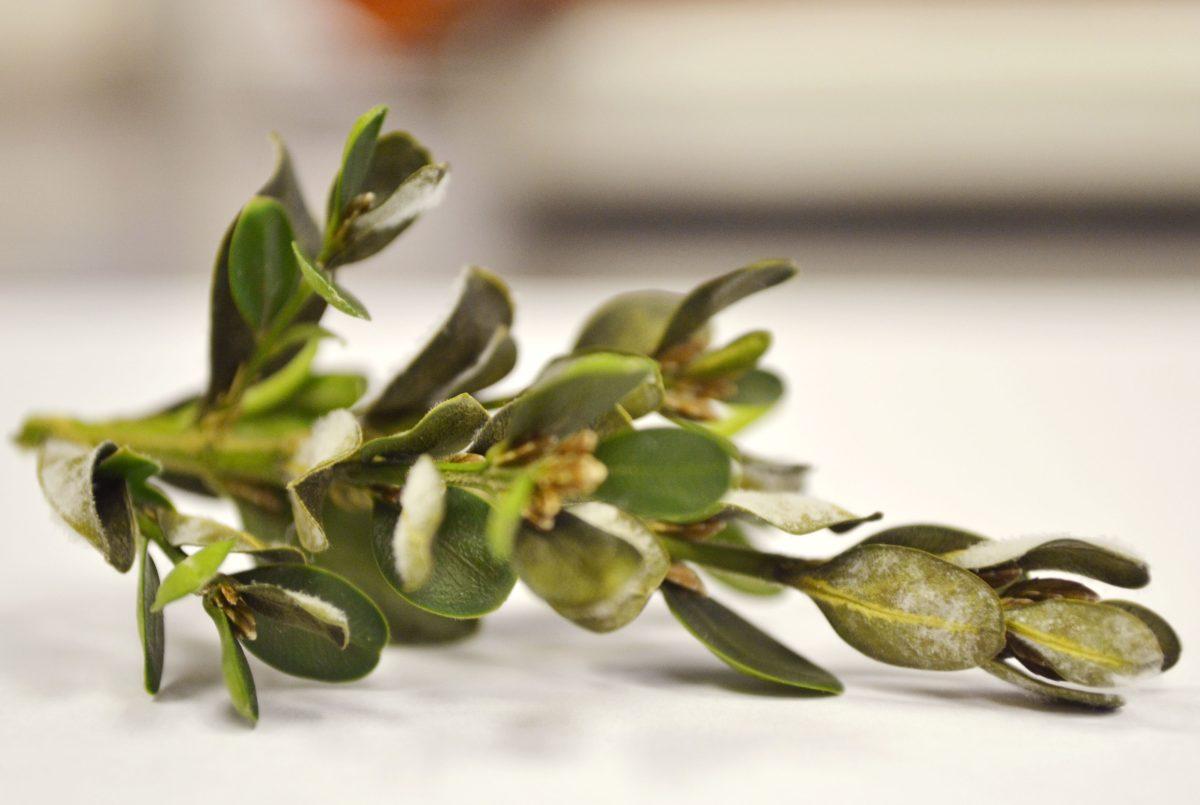Miranda Ganci, a graduate research assistant in plant pathology, doesn’t dare step foot in the JC Raulston Arboretum, N.C. State’s nationally acclaimed garden. If she does, there is a possibility that within weeks, dark brown or black lesions would start spreading across the leaves of all 156 boxwood plants growing there and dark streaking lesions would stretch along the stems, a sign of one of the most feared fungal pathogens in the boxwood world — the boxwood blight.
Ganci has been studying the fungus, called Cylindrocladium buxicola, since May of last year, as she was part of the team at N.C. State that first discovered the boxwood blight’s presence in the Unit ed States in October of 2011.
Easy to maintain and pretty year-round, with tightly packed leaves, boxwood has become one of the most popular shrubs and trees in the world. With a boxwood-growing industry valued at more than $20 million in North Carolina, the plants have become one of the most profitable investments for the state.
“It hurts your heart when you know how quickly a nursery can go out of business from a pathogen like this,” Ganci said. “Some fields are worth hundreds of thousands of dollars; all that can get destroyed in a matter of weeks by box blight.”
Although many people in the boxwood industry had known that boxwood blight was present in nurseries in Europe, New Zealand and other places before late in 2011, no one had thought that the disease had spread to the United States.
“It was first detected in a nursery in Western North Carolina, but when the nurserymen first discovered that there was a problem, they didn’t realize that it was boxwood blight,” Ganci said. “[They] reached out to N.C. State extension to help diagnose what was going on.”
The nurserymen reached out to Kelly Ivors, an associ ate professor and extension specialist in plant pathology. As soon as Ivors’ research team identified the disease as boxwood blight, the industry and researchers went into a managed frenzy, according to Ganci. “Being extremely aggressive, [boxwood blight] could wipe out millions of dollars’ worth of plants in a matter of months.”
Since N.C. State researchers first broke the news about the presence of boxwood blight in the U.S., the University has continued to do research about the disease and what boxwood plant nurseries can do to protect their in vestments.
Although all boxwood plants may look the same to many students, the species Buxus sempervirens has a lot of diversity with more than 365 cultivars. People can think of different cultivars in the same way they think of different dog breeds, Ganci said.
“The most common box wood [species] is Boxus sempervirens, and the most popular cultivars are the American and the English boxwood. The majority of boxwoods grown in the box wood industry are of those cultivars and, guess what? Boxwood blight is most aggressive on those.”
Ganci, along with Ivors and Michael Benson, a professor of plant pathology, started studying how susceptible to boxwood blight each cultivar is last summer. Cooperating with the Institute for Agricultural and Fisheries Research in Belgium, Ganci and the team has exposed the boxwood blight pathogen to different boxwood cultivars and measured each cultivar’s response.
“We did find some variation, which is good because now we have a tool that nurseries can use to help manage the pathogen,” Ganci said. “In order to manage the pathogen, you might say, ‘I’m going to start growing cultivars that are more resistant to these pathogens so if I am exposed to the pathogen in my particular nursery, all my plants won’t die.’”
Ganci and her fellow researchers rank the reactions of each boxwood cultivar using a “percent leaf area diseased rating” based on how much area on each leaf they see affected by lesions caused by the fungal pathogen. Although the team is still working to publish a copy of its findings, it has released some of the results online.
“I feel that hopefully we can find solutions that can be translated into a nursery area because a lot of people’s lives are affected, and the best thing that I can do is to help them so that they can keep doing what they love doing,” Ganci said. “If people want to grow healthy plants, I want to help make that possible.”








